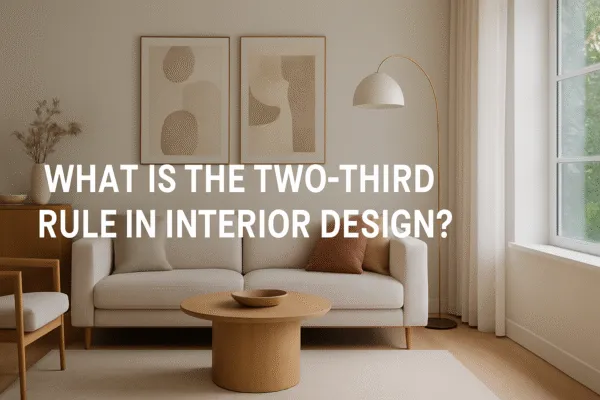
What is the Two-Third Rule in Interior Design?
Design is not just about making spaces look beautiful — it’s about balance, proportion, and harmony. One of the most timeless and effective design concepts is the two-third rule in interior design. This principle guides designers and homeowners alike in achieving aesthetically pleasing layouts that feel natural to the eye.
In places like Palm Desert, CA, where homes reflect a unique blend of modern luxury and desert charm, design rules are essential for creating balance in open floor plans, large windows, and high-ceiling spaces. Professional expertise, such as that offered by an Interior Designer in California, ensures these design principles are implemented thoughtfully, giving every room both function and style.
Understanding the Two-Third Rule
The two-third rule (often called the 2:3 ratio) is a visual design guideline suggesting that objects or spaces look better when divided unevenly rather than evenly. It’s rooted in the same idea as the “golden ratio,” where proportions that are slightly off-center appear more natural and pleasing than those that are symmetrical.
For example:
Hanging artwork at two-thirds the height of a wall instead of directly in the center.
Covering two-thirds of a sofa with pillows and leaving one-third open for balance.
Using a rug that fills two-thirds of a floor space rather than covering the entire area.
This proportion creates balance while avoiding monotony.
Why the Two-Third Rule Works
Humans are instinctively drawn to asymmetry when it feels intentional. Perfect symmetry can feel rigid or even boring, while asymmetry — when carefully balanced — creates interest and movement.
The two-third rule works because:
It prevents spaces from looking too heavy or cluttered.
It gives the eye a natural focal point.
It allows breathing space, ensuring designs feel inviting.
Applications of the Two-Third Rule
1. Wall Décor
Instead of centering one piece of art in the middle of a wall, designers often place it two-thirds of the way across the wall. Alternatively, gallery walls are often arranged with two-thirds coverage for better balance.
2. Furniture Layouts
In living rooms, sofas and chairs are often arranged to cover two-thirds of the room, leaving one-third open for traffic flow.
3. Lighting
Pendant lights often follow the two-third rule when suspended over kitchen islands or dining tables. Hanging them two-thirds of the way across creates balance without overwhelming.
4. Color Distribution
Designers often use color in a 2:1 ratio — two-thirds dominant color and one-third accent tones. For example, two-thirds neutral walls paired with one-third bold accents.
5. Textiles and Rugs
Rugs that cover about two-thirds of the floor under a seating area anchor furniture without making the room feel smaller.
The Two-Third Rule in Palm Desert Homes
Homes in Palm Desert, CA often feature expansive open layouts and panoramic desert views. Without careful balance, these spaces can feel too large or empty.
Here’s how the two-third rule enhances them:
Living Rooms: Sectionals arranged to cover two-thirds of the space create cozy gathering zones.
Bedrooms: Bedside décor, like lamps and art, follows the 2:3 proportion to balance tall headboards and wide walls.
Outdoor Patios: Furniture groupings occupy two-thirds of patio space, leaving one-third open for easy flow.
These thoughtful applications are why many homeowners turn to an Interior Designer in California to bring harmony to their homes.
Proportion and the Golden Ratio
The two-third rule has roots in the golden ratio, which has been used in architecture and art for centuries. While the golden ratio is precise, the two-third rule simplifies it for practical use in everyday decorating. Designers apply it instinctively to ensure that spaces feel both structured and organic.
Breaking the Rule
While the two-third rule is powerful, it’s not absolute. Designers may break it for:
Minimalist aesthetics where clean symmetry is the goal.
Formal spaces such as traditional dining rooms that require centered arrangements.
Artistic statements where balance comes from contrast rather than proportion.
The expertise lies in knowing when to follow the rule and when breaking it creates greater impact.
Professional Insight
Top designers, including those at Shelby Design Group, know that rules like the two-third principle are guidelines, not restrictions. They use it to establish balance but always adapt it to a client’s unique needs and the architectural character of the home.
By blending timeless rules with modern creativity, an Interior Designer in California ensures each project feels tailored yet harmonious.
10 FAQs About the Two-Third Rule in Interior Design
1. What is the two-third rule in interior design?
It’s a principle where spaces or objects are divided into two-thirds and one-third proportions for balance and appeal.
2. Why is the two-third rule important?
It creates asymmetry that feels natural, prevents clutter, and ensures visual interest.
3. Can the two-third rule apply to small spaces?
Yes, even in compact areas like studio apartments, using 2:3 proportions for furniture or wall décor creates balance.
4. How is the two-third rule used with wall art?
Artwork is often placed off-center, covering two-thirds of a wall for dynamic appeal.
5. Does the two-third rule apply to furniture arrangements?
Yes, it’s used to distribute seating, rugs, and accessories to avoid overly rigid layouts.
6. Can the two-third rule be applied to color schemes?
Absolutely. Two-thirds of a room in one color and one-third in an accent color creates harmony.
7. Is the two-third rule the same as the golden ratio?
They’re related, but the golden ratio is more mathematical, while the two-third rule is a practical guideline.
8. When should the two-third rule be broken?
In formal or minimalist spaces where symmetry is the design focus.
9. Can I apply the two-third rule outdoors?
Yes, it’s effective for patio layouts, landscaping, and outdoor furniture groupings.
10. Do professional designers always use the two-third rule?
They use it frequently but adjust based on the project’s style, goals, and client preferences.



